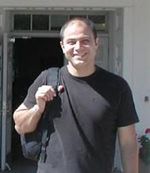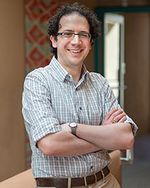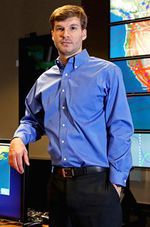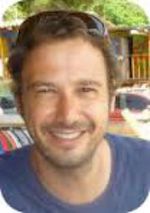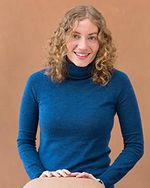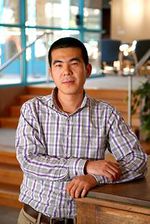Research Experiences for Undergraduates 2015-Potential Mentors
From Santa Fe Institute Events Wiki
| Research Experiences for Undergraduates 2015 |
A complete list of resident faculty list and our postdoctoral fellows can be found here
Potential Mentors and Projects
Cristopher Moore, SFI REU PI, Santa Fe Institute, Resident Faculty
Nihat Ay, Santa Fe Institute, Resident Faculty
Andrew Berdahl, Santa Fe Institute, Omidyar Fellow
Tanmoy Bhattacharya, Santa Fe Institute, Resident Faculty

Simon DeDeo, Santa Fe Institute, External Faculty
Beyond the Mind-Virus: the Cultural Phylogeny of Anti-Semitism
Beyond the Mind-Virus: the Cultural Phylogeny of Anti-Semitism
Simon DeDeo / simon@santafe.edu
(external faculty at Santa Fe; professor of Informatics and of the Cognitive Science department at Indiana University)
In any society, much of what passes for disinterested information is anything but: what individuals perceive to be {\it prima facie} reasonable facts are often complete fabrications. Their lack of veracity is compensated for by their social function.
One of the most persistent and perilous examples of this is anti-Semitism, the hatred and fear of the Jewish people. The varying yet correlated clusters of beliefs associated with anti-Semitism have been leveraged and incited by governments and mass political movements and have been a defining feature of global culture for thousands of years.
Far from being the simple ``mind viruses and memes described by Richard Dawkins, anti-Semitism is rather a network of prejudices and paranoias that draw on everything from envy and fear of political elites to hygenic, moral and even sexual disgust. Varying in time and place, they force us to go beyond simple population-genetic models of cultural transmission, to look at epistatic interactions among syntactic and semantic variations in core texts drawn from the Hathi Trust, a large-scale library digitization project of which Indiana University is a member.
- What we'll do
We can understand the cognitively complex development of this phenomenon by analysis of multiple editions of some of its most virulent and persistent documents, including such texts as the ``Protocols of the Elders of Zion and ``Conspiracy of the Six-Pointed Star.
We will learn some core tools for the modeling of natural language texts, including "topic modeling", a sophisticated statistical tool to extract large-scale regularities in word co-occurrence. Topic modeling has been used for everything from tracking signal emergence in the French Revolution to the study of Charles Darwin's reading habits. Here, it should allow us to decompose some of the themes -- and stylistic patterns -- of the texts, and thus the key ideas in play. Topic modeling should allow us to construct a geometry of anti-semitic ideas (for students with a taste for abstract mathematics, there is a sub-project here in the differential geometry of information theory with anti-semitism as a sample space).
Given successful completion of stage one, and based on these results, we will attempt an ambitious reconstruction of the evolutionary history of anti-semitism in the 19th and 20th Centuries. We will use phylogenetic reconstruction to track the complex branching, fragmentation, and synthesis of the multiple threads that define this terrifying phenomenon, and graph clustering algorithms developed by other members of the institute such as the message passing algorithms of Zhang and Moore.
Getting clear scientific answers to even the most basic of the questions addressed here may have profound importance not only for the cognitive, social, and political sciences, but for policy makers and those working to understand and manage a global world where rapid communication and idea-sharing can lead to both great good and great ill.
An ideal student would have some experience with programming (e.g., Python) and some comfort with mathematical reasoning; we can teach on the job and ahead of time. Most importantly a prospective researcher should have a keen interest in the development of culture and how it interacts with the human mind. In a Summer of intense work on a topic of profound political importance, we can expect plenty of unexpected results.
The researcher on this project will work with Simon DeDeo, who will be in residence from June 6th through August 16th and able to communicate beforehand on potential readings and places to begin. This work is in collaboration with Cassidy Sugimoto, professor of Information and Library Sciences, also at Indiana.

Vanessa Ferdinand, Santa Fe Institute, Omidyar Fellow
Stephanie Forrest, Santa Fe Institute, External Professor
1. Understanding and evolving software diversity:
Neutral landscapes and mutational robustness are believed to be
important enablers of evolvability in biology. We apply these concepts
to software, defining mutational robustness to be the fraction of random
mutations to program code that leave a program’s behavior unchanged.
Test cases are used to measure program behavior and mutation operators
are taken from earlier work on genetic programming. Although software is
often viewed as brittle, with small changes leading to catastrophic
changes in behavior, our results show surprising robustness in the face
of random software mutations. Depending on the student's interest, the
REU project could either involve learning to use the GenProg software
and running new experiments, or it could involve developing theoretical
models based on earlier work in the biological literature.
2. Understanding and modeling large-scale cybersecurity threats:
Cyber security research has traditionally focused on technical solutions
to specific threats such as how to protect desktops and mobile devices
against the latest malware. This approach has greatly enhanced our
ability to defend against specific attacks, but technical improvements
will not be sufficient on their own. Today’s cyber issues involve
social, economic, organizational, and political components, which are
often pursued in isolation from technical reality. Forrest and Prof.
Robert Axelrod (Univ. of Michigan) are collaborating on project that
aims to address that gap by focusing on the problem of reducing risks
arising from cyber conflicts, especially those among state actors. Our
current plan is to focus on the attribution problem, that is, once a
cyberattack has been discovered, what does it take to hold a particular
actor responsible? Depending on the student's interest and background,
this project could entail statistical modeling, developing
game-theoretic or decision-theoretic models (e.g., when is it
advantageous to plant false flags), to researching the current (public)
state of the art for attributing cyberattacks.
3. Forrest and Moses are collaborating on a project to examine how ant
colonies and immune systems form distributed information exchange
networks to search, adapt and respond to their environments. The is
characterizing search strategies quantitatively in terms of how
information flows over networks of communicating components, in this
case, ants or immune cells. It will measure how information improves
performance, measured in terms of how quickly a colony finds seeds or
the immune system neutralizes pathogens. By studying in detail how
distributed interaction networks guide search in two distinct systems,
this project aspires to formulate a general theory describing how
decentralized biological networks are organized to search, respond and
adapt to different environments, and how they effectively scale up to
large sizes. As the research has progressed we have begun to test our
theoretical understanding of distributed search strategies by
implementing them as search algorithms in robotic swarms. This
demonstrates practical applications as well as providing a controlled
experimental system in which to test theoretical predictions.
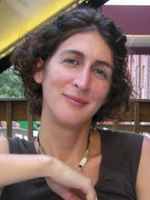
Mirta Galesic, Santa Fe Institute, Professor
Josh Grochow, Santa Fe Institute, Omidyar Fellow
Title: Exploring the space of algorithms, or, finding novel algorithms for hard and easy problems using genetic algorithms
Mentor(s): Josh Grochow
Despite nearly half a century of algorithm development, our understanding of algorithms is still shockingly poor. For example, how long does it take to multiply two n-digit numbers? The state of the art is nearly O(n log(n)) steps, much better than the standard way we are taught in elementary school. Yet it's consistent with current knowledge that this could be done in only O(n) steps - i.e., that multiplying two numbers is just about as easy as adding them! No one knows the right answer. Such issues are even worse for the famous P versus NP problem, which essentially asks whether brute-force search can always be improved upon. Unlike multiplying numbers, virtually no progress has been made on this problem in the half-century that it's been around.
Part of the reason for our paltry understanding of these questions is that, despite thousands of new algorithms, we've actually only explored a tiny corner of the space of all possible algorithms. This was brought home with the discovery in the early 2000's of so-called holographic algorithms - classical algorithms, inspired by quantum computing, that take advantage of surprising cancellations to efficiently solve problems that no one would have thought could be efficiently solved.
In this project we propose to explore more of the space of algorithms by several methods. We'll mention one such method here, and can discuss others in person if you're interested.
We propose to use novelty-seeking genetic algorithms to help find examples of truly new classes of algorithms. Given that genetic algorithms have long been used to search for new and better algorithms, what's special here? At least three things: (1) in the last decade or so there have been great advances in using genetic algorithms to search for novel solutions, rather than to directly search for better solutions; whether or not this finds better algorithms, in looking to further explore the space of algorithms, novelty is a key aspect; (2) the methods used in these novelty-seeking algorithms, such as indirect encoding, match up well with frontier problems in computational complexity, and (3) we propose to apply genetic algorithms to problems that we think may not have efficient solutions, such as NP-hard problems. If the genetic algorithm fails to find a good algorithm, we hope to still extract some insight from the bad algorithms it finds. Our hope is that we'll either find genuinely new algorithms for these problems, or that we'll gain theoretical insight into how hard these problems truly are.

Laurent Hebert-Dufresne, Santa Fe Institute, Postdoctoral Fellow
Alfred Hubler, Santa Fe Institute, External Professor
Eric Libby, Santa Fe Institute, Omidyar Fellow
John Miller, Santa Fe Institute, External Professor
John Pepper, Santa Fe Institute, External Professor
Project Proposal:
This project is to refine and implement a new evolutionary heuristic algorithm for a classic NP-hard spatial optimization problem called the “Traveling Salesman Problem”
The implementation could be done in any object-oriented programming platform with good spatial graphics, so we could decide that part together if you’re interested.
-Faculty mentor: Dr. John W Pepper, external faculty

John Rundle, Santa Fe Institute, External Professor
Sam Scarpino, Santa Fe Institute, Omidyar Fellow
Markus Schlapfer, Santa Fe Institute, Postdoctoral Fellow
Caitlin Stern, Santa Fe Institute, Omidyar Fellow
Pan Zhang, Santa Fe Institute, Postdoctoral Fellow


